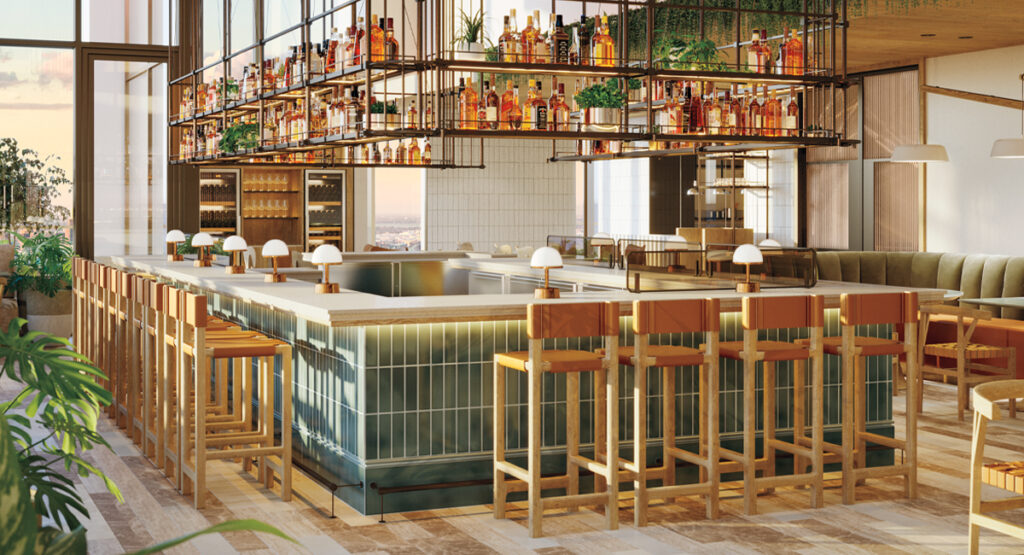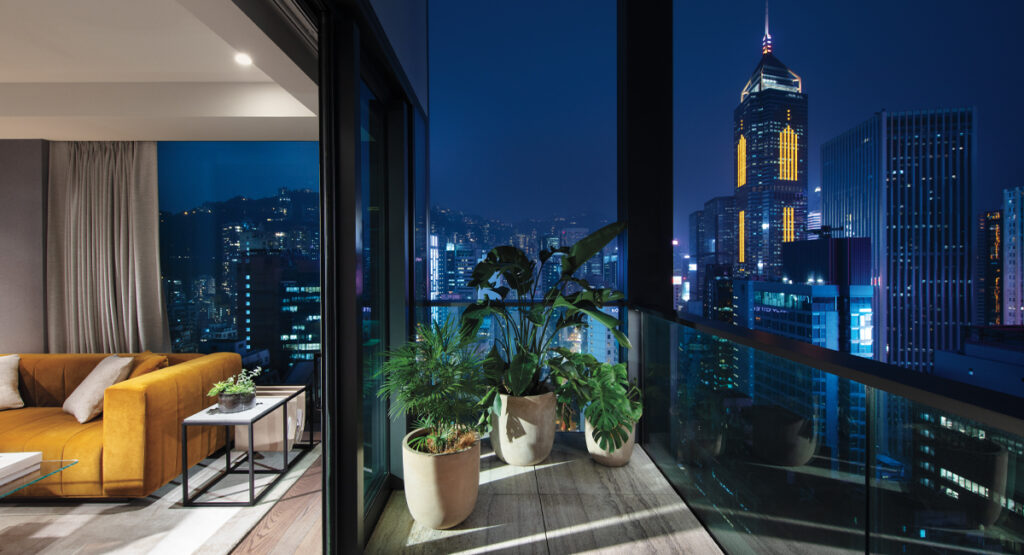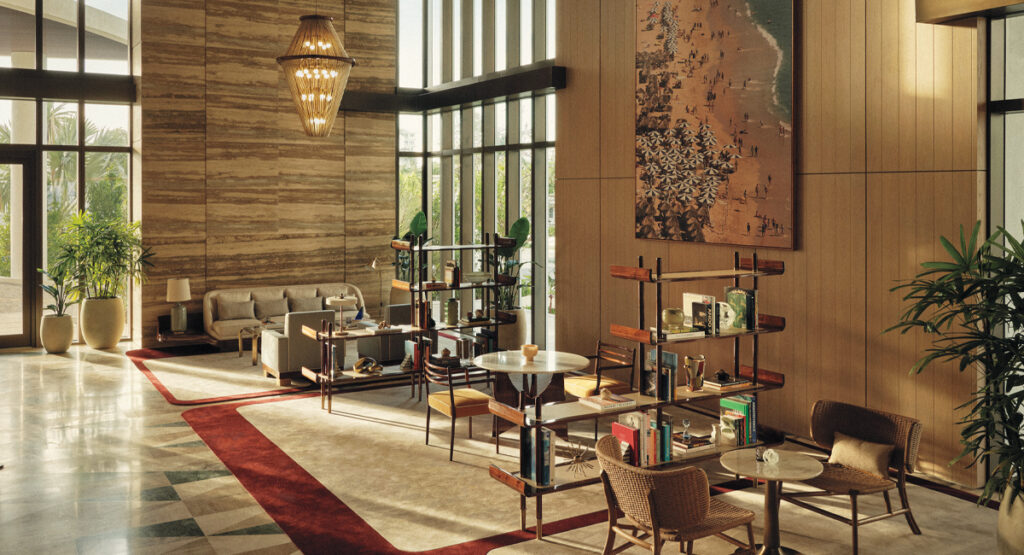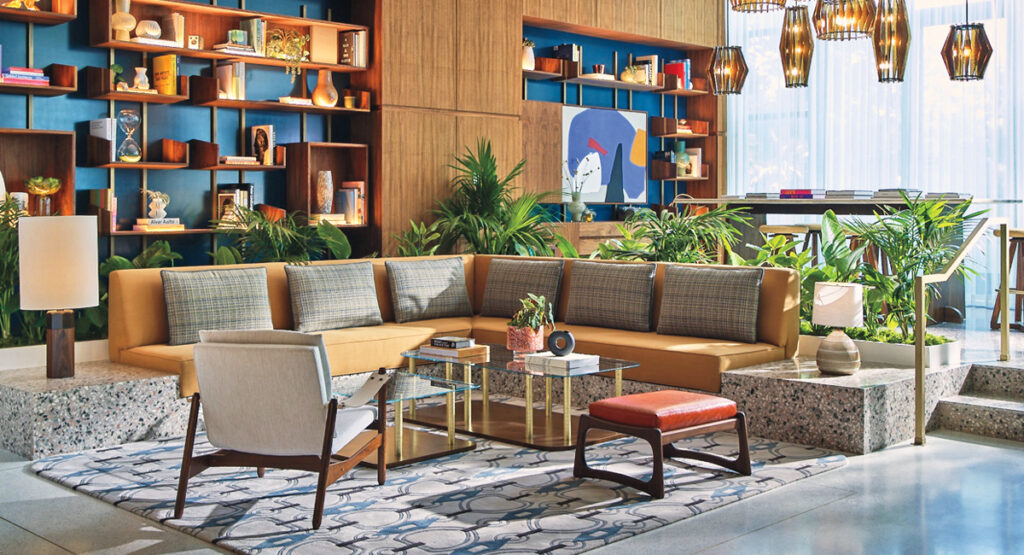The interior designer’s latest project is the new Conrad Los Angeles
When Starchitect Frank Gehry broke ground for his Grand LA construction project in California in 2019, it was the beginning of a behemoth downtown presence—a vast billion-dollar complex sitting opposite his iconic Walt Disney Concert Hall, in all its reflective, curlicued glory. The Grand LA, which opened in July, was conceived as a self-contained city block. For years Bernerd had been working alongside Gehry, intent on creating interiors that live up to the dramatic promise of the exterior. “It’s a beast of a project,” she says, gesticulating with fingers covered in articulated and highly decorative armor-like rings by her friend Loree Rodkin. “The Conrad hotel, which is a core part of it, has 305 bedrooms, incredible restaurants, three bars and a huge pool deck. Just to walk around its entirety takes three hours.”

Bringing a sense of intimacy and emotion to such a project is a conundrum. Any talented interior designer can create a boutique hotel with a few swatches and a whimsical backstory. But as lead interior architect and designer for the whole of Grand LA, Bernerd had to step back to see the bigger picture: “We created staggered ceilings, with graded curves, and considered every single column before we even began to think about the walls and floors. We had to think about so many things, because it’s residential as well as a hotel, along with all its other destination elements. We’ve been able to inject a lot of warmth and a sense of seduction in the spaces, and even before anyone dined in any of the restaurants, we had so many emails from chefs and industry people saying how excited they are, just from a preview.” Bernerd has been creating interiors for close to 20 years, and while she still does the occasional private home, it’s the hotel world where she spends most of her time. Asked to define her style, she says she always aims for something “seductive and aspirational, but still cool.” Many point to an industrial aesthetic that runs through her projects, but always with a warmth to it. “There are certain books I have in my office that I return to time and time again,” she says. “There is one on Maison de Verre—the ‘House of Glass’—by Pierre Chareau and Bernard Bijvoet, which was designed in Paris in the 1920s. It was one of the first times we had seen what we would now call loft living, and it’s always influenced me: the steel columns and girders, and the use of burgundy and iron-framed glasswork. I’ve also been heavily influenced by the modernist Mexican architect Luis Barragán, whose old house and studio in Mexico City is now a UNESCO World Heritage Site.”

Unlike a lot of contemporary designers, despite common denominators in her influences, there isn’t a single obvious style attributable to the Tara Bernerd studio. Every project she has done for Belmond, the Four Seasons, Rosewood, Sixty, Starwood and Thompson has its own DNA. There is always wood, and strong color, and comfort, and that aforementioned industrial essence, but the mix and balance are always dependent on the location. What works in London is different from, say, Hong Kong, although she has created Hari hotels for the same owner, Aron Harilela, in both cities. “The interesting thing about The Hari is that it’s not a huge corporate operator,” says Bernerd. “Aron is a great friend, and when we started working together, we were creating a new brand. Each of the hotels has an urban sophistication to it but is also unique and of its place. When we worked on Hong Kong, we were paying homage in a way to the London hotel, but we changed certain shades of green—with darker tiles on the floor in Lucciola, the restaurant—and used different shapes of furniture. But the consistent motif is the concept of men’s tailoring. I chose fabrics to reflect Savile Row, because Aron is obsessed with his amazingly cut English suits.”
In London, The Hari is finished with a darker palette and warm leathers. It’s the same level of tactile luxe as the new Conrad in California, but in L.A. every room beams with the kinds of tones synonymous with the golden hour toward the end of a day by the Pacific. She knows what works with the history of a city, and the quality of light it has.
A lot of the stories in Bernerd’s work come from her constant travel. The eccentricity of English heritage interiors, and the layers of color inherent to them, are part of her canon, but then so is the minimalism of Japanese homes—the clean lines and sparse but functional furnishing of traditional pavilion dwellings. “Travel opens my heart and mind,” she says. “I love it when I see someone else create an exciting combination of styles. I still think what Christian Liaigre did with The Mercer in New York back in the 1990s is a knockout. The energy and attitude are great—the mix of brick walls and seductive velvet seating. I love a room that conjures up a feeling, like the Hotel Costes in Paris, and also some of the real old classics, like the Splendido in Portofino. Even though our way of life has changed a lot, I always think we can learn a lot from the grande dame properties, like The Carlyle in New York and Claridge’s in London.”

When Bernerd was working on a new Four Seasons in Florida recently, she did what she always does, and made copious notes on the story she was going to tell. The property in Fort Lauderdale is waterside, so she wanted it to have the essence of a yacht club. But she also wanted it to have a depth that a lot of modern Florida properties lack. “Many people think about that part of the country as where you go for spring break,” she says. “As a stranger to that culture, I was able to forget about that and essentially work against it. Sometimes it’s a real benefit to go into something without being influenced by previous connotations. Instead, I wanted a mixture that brought something of the French Riviera. We wanted an understated elegance that was subtly Mediterranean. We didn’t want a generic look. We put in magnificent flooring, and furniture that is highly varnished, so it makes you think of those luxury boats you might see by Riva on Lake Como. The most important thing is that it felt comforting, and like a home, despite it being a substantial resort.”
Working on an international scale involves a large team, and various assistants who can seek out the best makers in each country. Bernerd is currently creating a hotel for Belmond on Maroma Beach in Mexico that was originally a private home, and her team is busy finding the best artisans who can work in local stone and wood. There’s no such thing as a low-budget Tara Bernerd project. “I choose beautiful materials that will last forever,” she says.
While Bernerd’s look is modern, it’s not overburdened with technology. “Lighting is crucial,” she says. “One of the reasons why Costes in Paris is so good is because it’s lit to be sexy. It sometimes feels like you need a flashlight to actually get to your room, but that works. I always collaborate with experts about what we should put in—I don’t want too many downlighters, and I want the art that we have chosen to be lit properly. And the light has to change according to the time of day. Technology is really difficult because what’s current today is outmoded tomorrow. Things should be intelligent, up to speed, and hidden. You don’t want to have to roll a towel up to cover lights that come on in the middle of the night along the floor when you go to the bathroom. And you don’t want a power socket hardwired into the wall that a company then stops using on their devices, so you have to change everything.”

One thing that all Bernerd’s hotels have in common is a sense of pleasure. It is in the warm lighting in a restaurant that makes everyone look good, and it’s in the way the rooftop pool is arranged at Thompson Hollywood that makes the place feel glamorous. Her use of marble and patterned floorings and scale makes everything feel grand, but always pleasing to the eye. Her bathrooms are functional and bright as well as luxurious. All of these are places you want to linger. While we’ve experienced the revolution of home sublets around the world, there’s still nothing quite like a buzzy hotel lobby and bar to make you feel connected to somewhere new and exciting. When you’re at Bernerd’s Four Seasons Downtown in New York, you know where you are. It is three-olive martinis, strip steaks and Wall Street.
It’s surprising that, despite creating bespoke pieces for just about every project to date, Bernerd has yet to launch her own line. There have been pieces produced by The Rug Company—textile floor coverings bearing huge monochrome butterflies—but her peers, including Yabu Pushelberg and Patricia Urquiola, all have extensive collections of their own furniture. When will we see her universe expand to incorporate work we can have at home? “Actually, I’m going to Italy next week to talk about exactly that,” she says. “I’ve been nervous about doing it, because I’d feel compelled for us to pull pieces from our own range, as well as other designers’ work, for a project. But we’ve been designing for so long now, and we have so many pieces we could make, and had so much feedback from people who want them, so it’s going to happen. But after 20 years, it will be hard to edit down to a capsule collection.”
